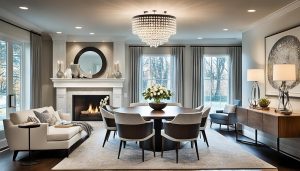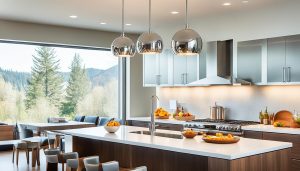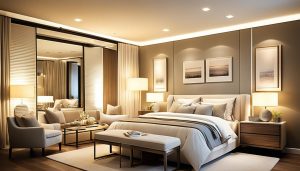As you move through your home, light can either make the mood or leave you feeling let down. Lighting is key to interior design, making a big difference when done well. Finding the right lighting fixtures can be fun and a bit challenging.
This guide will lead you through the lighting world. We’ll cover different types, bulb options, and what to consider for each room. Get ready to brighten your space and make it just how you want it.

Lighting is key in interior design, affecting the look, feel, and use of a space. To pick the right lights, knowing the lighting basics is crucial. There are three main lighting types: ambient, task, and accent lighting.
Ambient lighting gives a balanced glow for daily life. Task lighting shines light on specific tasks like reading or cooking. Accent lighting highlights certain areas or objects, adding beauty to a room.
Choosing the right light bulb is as crucial as picking the right fixture. There are incandescent, halogen, fluorescent, and LED bulbs. Each has its own energy efficiency, color temperature, and lifespan.
Color temperature, measured in Kelvin (K), shows the light’s hue. Warmer bulbs (2700K-3000K) give off a yellow light. Cooler bulbs (4000K-6500K) produce blue-toned light. The light’s color temperature can change a room’s mood and atmosphere.
Layering different lighting creates a balanced scheme. Using ambient, task, and accent lighting meets various needs. This approach improves a room’s look and highlights special items.
Learning about lighting basics helps in choosing the right fixtures. By understanding lighting types, bulb options, and layering, you can create a lighting scheme that looks good and works well. This enhances your space’s design and meets your needs.
Choosing the right light fixture for each room is key. The function of the space is a major factor. For example, a kitchen needs task lighting, while a living room should have ambient lighting for a cozy feel. A home office or study area requires good lighting for reading and working on the computer. Bedrooms need a mix of ambient and task lighting.
Lighting designers stress its role in interior design. It’s vital for transforming a space. A balanced design includes ambient, task, accent, and decorative lighting. Getting the right mix is crucial for a flexible lighting scheme.
Daylight affects how we place elements in a room. Artificial light is key for visual stimulation and highlighting room features. Decorative lighting adds beauty and works well with architectural lighting.
The quality of light matters, measured by CRI and color temperature. Warm white light (2700K-3000K) is calming, while cool white (4000K-5000K) is energizing. Daylight (5000K-6500K) boosts mood and productivity.
Think about each room’s function when picking light fixtures. This way, you get a space that’s both comfortable and functional. Whether it’s task lighting for your office, ambient lighting for your living room, or a mix in your bedroom, the right lighting changes how you use and enjoy your home.
“Lighting is considered essential for good interior design, emphasizing good design features and downplaying any flaws.”
The living room is the heart of the home, where families gather and make memories. Choosing the right lighting is key to setting the perfect mood. It makes the space functional and beautiful. Whether you want a cozy feel or a bright look, knowing about living room lighting can help.
Ambient lighting sets the mood in a living room. It provides overall light and shapes the space’s feel. Chandeliers, pendant lights, and flush-mount fixtures are great for this. They light up the room and add to the decor.
Task lighting is vital for activities like reading or watching TV. Floor lamps and table lamps work well for this. They give focused light where you need it, making the room functional.
Accent lighting highlights special features or artwork. Wall sconces, track lighting, and decorative lamps are good choices. They add depth and interest to the room.
Using ambient, task, and accent lighting together creates a balanced look. Try different fixtures and placements to find what works best for you. This way, your living room will be both beautiful and practical.
| Lighting Type | Purpose | Fixture Examples |
|---|---|---|
| Ambient Lighting | Provides overall illumination and sets the tone for the space | Chandeliers, pendant lights, flush-mount fixtures |
| Task Lighting | Provides focused light for specific activities, such as reading or watching TV | Floor lamps, table lamps |
| Accent Lighting | Highlights architectural features, artwork, or other design elements | Wall sconces, track lighting, decorative table lamps |
“Lighting can make or break the ambiance of a living room. By layering different types of lighting, you can create a warm, inviting space that caters to both practical and aesthetic needs.”
Choosing the right kitchen lighting is key to making your space both functional and welcoming. There are two main types: overhead lighting and under-cabinet lighting. Knowing what each type does helps you light your kitchen just right.
Most kitchens rely on overhead lighting for main illumination. Options include chandeliers, pendant lights, and flush mounts. Think about the size, brightness, and style to match your kitchen’s look. Pendant lights are now popular for adding a statement above islands or dining areas, with unique designs.
Under-cabinet lighting adds light to countertops and work areas, helping with cooking and food prep. LED strips, puck lights, and linear lights are common choices. Look for brightness, color temperature, and easy installation to fit your kitchen’s needs.
LED lighting fixtures are popular for their energy savings and modern look, often built into cabinets or recessed. Industrial-inspired designs bring a city feel to kitchens, while mixed metal finishes add depth to decor.
| Lighting Type | Purpose | Design Considerations |
|---|---|---|
| Chandeliers | Focal point and ambient lighting | Sophisticated, glamorous |
| Pendant Lights | Task and accent lighting | Statement pieces, bold designs |
| Flush Mounts | General overhead lighting | Streamlined, unobtrusive |
| Under-Cabinet Lighting | Task lighting for countertops | Energy-efficient, integrated designs |
By thinking about the various kitchen lighting options, you can make your space bright and beautiful. It will meet both your needs and your style.

“Lighting is the jewelry of the home – it’s what really makes a space come alive.”
The dining room needs a mix of lighting types for a warm and welcoming feel. Chandeliers and sconces add a touch of elegance. Table lamps provide focused light for tasks. Each lighting type is important for the room’s look and feel.
Dining room lighting shines with chandeliers and pendant lights. These lights become the room’s centerpiece, adding elegance. Make sure to match the light’s size with your dining room’s dimensions and ceiling height.
Wall sconces and table lamps offer task lighting. They light up specific areas and highlight room features. These lights make the room well-lit and balanced.
Choosing the right dining room lighting matches your room’s style. Pick fixtures that fit with your furniture and décor. Try out different finishes and shapes to find what suits you best.
“Lighting can transform a space, setting the mood and creating a welcoming atmosphere. In the dining room, it’s all about finding the right balance between ambient, task, and accent lighting to create a truly inviting experience.”
Success in dining room lighting comes from balancing function and style. By picking the right lights and placing them well, you can make your dining room warm and striking. This makes it perfect for memorable meals and gatherings.
The bedroom is where you find rest and relaxation. Lighting is key to making it perfect. By choosing the right mix of ambient and task lighting, your bedroom can become a cozy and useful place.
Ambient lighting, like ceiling lights or wall sconces, lights up the room and sets the mood. Place these lights to spread a warm, welcoming light. Look for dimmable options to change the light as you like.
Task lighting, such as bedside lamps or reading lights, is vital for activities like reading or getting ready. These lights should shine where you need it most.
Combining ambient and task lighting makes your bedroom well-lit and useful. Aim for a balance between looks and function. This way, your bedroom becomes a place of rest and comfort.

“Bedside lighting can make a small bedroom feel bigger or add intimacy to a larger room,” says Sally Storey of John Cullen Lighting.
Good lighting in the bedroom boosts your happiness, energy, and well-being. With a mix of ambient and task lighting, your space will look good and work well. This lets you relax and recharge fully.
Lighting is key to making your bathroom feel like a spa. It helps with tasks like grooming and sets the mood. The right lights can change how your bathroom looks and works.
Vanity lighting is key for grooming tasks. Urban Ambiance has 178 vanity light models in styles like contemporary and vintage. This means you can find the perfect light for your mirror.
Ambient lighting adds a relaxing feel to your bathroom. Urban Ambiance offers 15 Urban Industrial-style lights and 18 Vintage Electric-style ones. These can be wall sconces or recessed fixtures.
When picking lights, think about your bathroom’s size and the brightness you want. Where you place the lights is also important to avoid shadows. Mixing different types of lights creates a beautiful look.
For mirrors, Urban Ambiance suggests hanging lights above them. The size of your mirror affects how many lights you need. It’s important to balance natural and electric light, especially with skylights.
Changing an old bathroom light is easy and can be done in a day. Most modern bathrooms have vanity lights and lighted mirrors. This makes the space both useful and stylish.
About 70% of bathrooms use recessed lighting for general light. Dimmable lights are popular in 60% of cases for more control over the mood.
Chandeliers add elegance to larger bathrooms. About 25% of these bathrooms choose them. Make sure the chandelier fits the room’s style.
There are many lighting options for your bathroom, from sconces to pendants. Urban Ambiance has a wide range of styles, like contemporary and vintage. You can easily find the perfect lights for your bathroom.
Lighting is key to making your living spaces look great. It can turn a room into a beautiful place with the right lighting choices. Decorative fixtures and accent lighting can make your home look amazing.
Things like chandeliers, pendant lights, and wall sconces add beauty and elegance. They create a warm, inviting mood in any room. This makes your living spaces feel cozy and welcoming.
Accent lighting highlights certain parts of your room. It draws attention to special features, like artwork or furniture. This lighting adds depth and makes your decor stand out.
Using energy-efficient lighting like LED bulbs is smart. They save energy and come in different colors to match your lighting needs. Smart lighting systems let you control the brightness and mood easily. This is great for any event.
Choosing the right lighting fixtures can make your home look better. It shows off your style and makes your living spaces more enjoyable.
“Lighting has the power to transform a room, setting the mood and accentuating the design elements that matter most.”
Whether you want elegance, a cozy feel, or energy efficiency, the right lighting makes a big difference. It can make your home look better.
Choosing the right lighting for your home is key to making it both comfy and good-looking. By learning about lighting basics and the importance of room function, you can make a lighting plan that boosts your home’s design.
When updating your kitchen, living room, or bedroom, think about what each room needs and how it looks. Pick fixtures that give the right amount of light and match your decor. This way, you can change your home with smart lighting choices.
Using natural light, energy-saving LED bulbs, and different types of lighting can make your space perfect. Avoid common mistakes and focus on the room’s function. This will help you make a home that shows off your style and tastes.